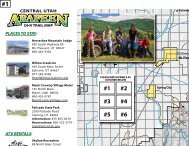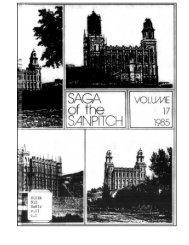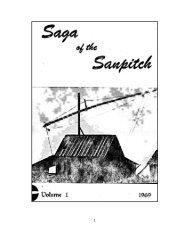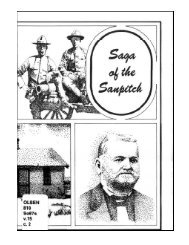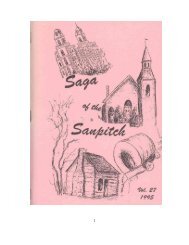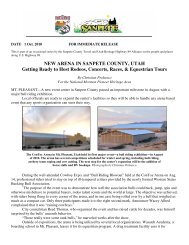Saga of the Sanpitch Volume 13, 1981 - Sanpete County
Saga of the Sanpitch Volume 13, 1981 - Sanpete County
Saga of the Sanpitch Volume 13, 1981 - Sanpete County
- TAGS
- saga
- sanpitch
- volume
- sanpete
- sanpete.com
You also want an ePaper? Increase the reach of your titles
YUMPU automatically turns print PDFs into web optimized ePapers that Google loves.
The recorder <strong>of</strong> Gunnison City recorded in <strong>the</strong> minutes: "By proclamation <strong>of</strong> <strong>the</strong> Mayor, Joseph<br />
Christenson, be it duly posted July 7, 1915, that said city limits <strong>of</strong> Gunnison City be dry."<br />
This action by <strong>the</strong> City Council brought a lot <strong>of</strong> contention from <strong>the</strong> "wets." Marinus Beauregaard,<br />
contestant for <strong>the</strong> "wets," brought suit against <strong>the</strong> City Council: Marinus Beauregaard contestant versus<br />
Gunnison City Council, to-wit Joseph Christenson, Mayor, John M. Knighton, Axel Modeen, Moroni Childs, E. L.<br />
Swalberg, and W. H. Gribble, councilmen, and Neil Sorenson, City Recorder. The case was tried before Joseph<br />
H. Erickson, Acting Judge. No defendants <strong>of</strong> Gunnison City entered in <strong>the</strong> case, except <strong>the</strong> defendant, E. L.<br />
Swalberg. After <strong>the</strong> Hearing, <strong>the</strong> case was decided in favor <strong>of</strong> E. L. Swalberg and against <strong>the</strong> contestant<br />
Marinus Beauregaard.<br />
It was <strong>the</strong>n appealed by <strong>the</strong> contestant to <strong>the</strong> Supreme Court <strong>of</strong> <strong>the</strong> State <strong>of</strong> Utah on October 16, 1916.<br />
The Supreme Court reversed <strong>the</strong> decision <strong>of</strong> <strong>the</strong> District Court and demanded a new trial.<br />
In <strong>the</strong> new trial, E. L. Swalberg filed a stipulation in <strong>the</strong> case, consenting <strong>the</strong> case may be heard on<br />
December 4, 1916. The result <strong>of</strong> <strong>the</strong> election was hereby set aside, vacated, and annulled. The headlines read:<br />
THE TERRITORY OF GUNNISON CITY IS WET!<br />
But while <strong>the</strong> trials were going on, Gunnison was dry. That was from October 1, 1915, to December 9,<br />
1916. After all o<strong>the</strong>r towns in <strong>the</strong> State had dried up, Gunnison was still wet for a period <strong>of</strong> 60 days. That made<br />
Gunnison <strong>the</strong> last town in <strong>the</strong> State to go dry. Gunnison was really "Little Chicago" <strong>the</strong>n, when no one could<br />
buy a drink in Salt Lake City anymore. On February 8, 1917, Governor Simon Bamberger signed <strong>the</strong> Prohibition<br />
Bill for <strong>the</strong> State <strong>of</strong> Utah.<br />
Source: Gunnison Gazette<br />
Gunnison City Council minutes<br />
Court Records at <strong>the</strong> <strong>Sanpete</strong> <strong>County</strong> Court House<br />
Personal recollections <strong>of</strong> <strong>the</strong> author<br />
Note: The author finished this article for <strong>the</strong> "<strong>Saga</strong>" contest just one week before he passed away, March 28, <strong>1981</strong>.<br />
WESTERN SAGEBRUSH<br />
Vernon F. Larsen<br />
3981 Fruitvale Avenue<br />
Oakland, CA 94602<br />
Senior Citizen Division, Second Honorable Mention Historical Essay<br />
There have been songs and stories written about <strong>the</strong> purple sage, but if you have never seen it,<br />
smelled its sweet odor or sampled its bitter taste, you will never appreciate <strong>the</strong> true nature <strong>of</strong> Western Sage.<br />
It is native to Colorado, Wyoming, Utah, Nevada and Nor<strong>the</strong>rn California. In some desert places it flourishes as<br />
<strong>the</strong> only living plant.<br />
Explorers, pioneers and travelers walked through it, rode through it, smelled and made bonfires with it.<br />
Its leaves and tiny flowers seem to lend a purple hue to <strong>the</strong> distant landscapes. Nevada is proud to be called<br />
"The Sage Brush State," and has adopted it as <strong>the</strong> state flower.<br />
There is evidence that <strong>the</strong> Indians used sagebrush for medicinal purposes. Mormon pioneers made<br />
similar use <strong>of</strong> it. They ga<strong>the</strong>red <strong>the</strong> blossoms and leaves, dried and stored <strong>the</strong>m in cans. These would be<br />
brewed into a strong tea. It was a bitter concoction, but was used for fevers, colds, headaches and various<br />
ailments. My grandmo<strong>the</strong>r claimed sagebrush tea was a "cure-all" for many illnesses. She used a concentrated<br />
solution <strong>of</strong> it to dye cloth.<br />
37



